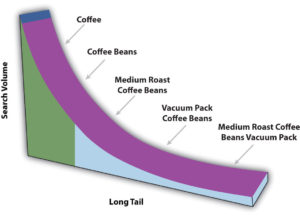If you have read anything about Search Engine Optimization (SEO) you probably have encountered the concept of keywords. First, let’s be clear on the definition of the term keyword in SEO.
Essentially a keyword is an informative word used to identify the content of a document that is then indexed in an archive. In the world of websites and the Internet, keywords define the topic or idea that is central to an individual piece of content like a web page or a blog post. These are the words that search engines use to identify and index your website and its content. These are also phrases that your business prospects use when seeking answers and information through any web browser.
Simple words and phrases can identify your web pages—copy, images, and video. These are your primary keywords.
Primary Keywords
Take the website for the law firm Williams & Salatino Family Law. Wouldn’t it make sense to use the name of the firm as a primary keyword? Or would you use the generic law firm, attorney, family law firm, family law?
Those are all reasonable keywords, but put yourself in the shoes of the researcher. The searcher will use the full firm name only if he knows it by word of mouth or some form of advertising, right? How many other law firms use the same name? Not much competition, I bet.
First, if your person types in “law firm,” Google will automatically narrow the search by geographic proximity. Yet still, there would be lots of competition and the legal directory results will rule the search results.
Next, it is more likely that the person seeking services will narrow the search to family law attorney or more specifically divorce lawyer! Already you can see that there will be many variations of even the most generic keyword to help your prospects find you.
Unless you are in a very small town, there will likely be a great deal of competition for ranking for these general terms on the first page. It will take a real investment to fight your way to the top with these terms.
Try This
Write down a few variations of the primary keywords which you want to use for your website. If you are interested, I wrote a blog post on some simple steps for keyword research.
Measuring Keywords by Volume and Competition
I mentioned that even variations on the primary keyword that describe your professional, services, or products are likely to be highly competitive. What does this mean?
In general, keywords that are used frequently in searches are highly competitive. The more people searching for that keyword the better, right? It’s a bigger pool to draw from. The hitch with that thinking is that everyone else is thinking that too. More businesses, pages, and pieces of content are using that same keyword. You have to have sharp elbows and a big enough budget for your SEO campaigns to cut through the crowd.
Luckily a broader keyword strategy takes advantage of additional keywords.
Using Long-tail Keywords
In addition to the high competition crowd issue, broader keywords like attorney, pools, or therapy are very vague. Pools? Pool building or pool repair? What kind of pool?
Therapy or therapist are maddeningly generic. Massage therapist, couples therapist, or physical therapist are only moderately better.
While it is true that many people will search by the terms above instead of the even more generic “therapy” it is also true that many searches use longer phrases such as full questions.
For many industries, services, and even products, our would-be customers research online and ask all manner of questions in the search window to learn more about what they want and where they might find it.
My buyer personas are curious about internet marketing and will ask many questions such as
“What is SEO?”
“Starting a blog”
“optimize my website”
“How much does it cost to build a WordPress website?”
We call these more specific phrases long-tail keywords. They are called long-tail because of where they fall on a graph of keywords by volume.
Long-tail keywords have less competition and therefore fall somewhere on the long tail that stretches to the right close to the x-axis or horizontal line in a graph on a coordinate grid.

Finding Your Longtail Keywords
Make a list of all the products and services you offer—every single one. The graph above shows the breakdown of products from generic coffee to a very specific “medium roast coffee beans vacuum pack.” Any person using such specific terms is clearly seeking to buy–highly likely to convert.
Perhaps your product or service is rarely purchased swiftly—like coffee when you really need it—then you should consider what your buyer wants to know before they purchase. They are researching and asking questions.
Now you can start writing down all the questions you have heard from your customers, clients, and prospects over the years.
A few of these questions will top the list as your FAQs. Both the specific topic of that question and the question itself are potential long-tail keywords.
You will find that there are many long-tail keywords that you could use. In a well-developed keyword strategy using fresh optimized content, you can write one blog post, website page, or video to focus on each long-tail keyword.
Next Steps
Finally, you will want to conduct keyword research to prioritize the keywords to use. More on that in a later post.
